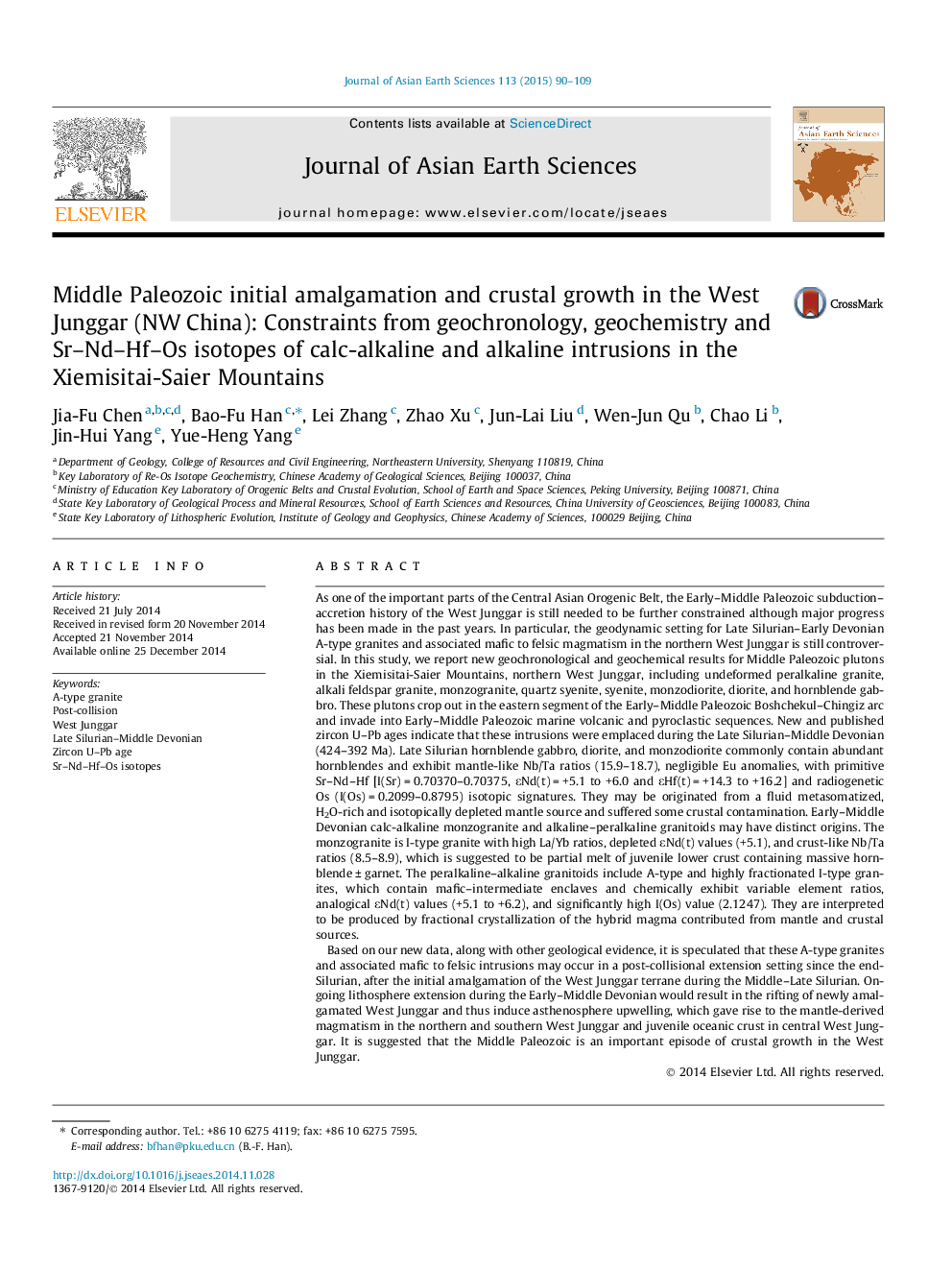| کد مقاله | کد نشریه | سال انتشار | مقاله انگلیسی | نسخه تمام متن |
|---|---|---|---|---|
| 4730217 | 1356743 | 2015 | 20 صفحه PDF | دانلود رایگان |

• Early Devonian Xiemisitai A-type granites were formed by fractional crystallization of hybrid magma.
• The initial amalgamation of West Junggar occurred during the Middle–Late Silurian.
• Middle Paleozoic is an important vertical crustal growth episode in the West Junggar.
As one of the important parts of the Central Asian Orogenic Belt, the Early–Middle Paleozoic subduction–accretion history of the West Junggar is still needed to be further constrained although major progress has been made in the past years. In particular, the geodynamic setting for Late Silurian–Early Devonian A-type granites and associated mafic to felsic magmatism in the northern West Junggar is still controversial. In this study, we report new geochronological and geochemical results for Middle Paleozoic plutons in the Xiemisitai-Saier Mountains, northern West Junggar, including undeformed peralkaline granite, alkali feldspar granite, monzogranite, quartz syenite, syenite, monzodiorite, diorite, and hornblende gabbro. These plutons crop out in the eastern segment of the Early–Middle Paleozoic Boshchekul–Chingiz arc and invade into Early–Middle Paleozoic marine volcanic and pyroclastic sequences. New and published zircon U–Pb ages indicate that these intrusions were emplaced during the Late Silurian–Middle Devonian (424–392 Ma). Late Silurian hornblende gabbro, diorite, and monzodiorite commonly contain abundant hornblendes and exhibit mantle-like Nb/Ta ratios (15.9–18.7), negligible Eu anomalies, with primitive Sr–Nd–Hf [I(Sr) = 0.70370–0.70375, εNd(t) = +5.1 to +6.0 and εHf(t) = +14.3 to +16.2] and radiogenetic Os (I(Os) = 0.2099–0.8795) isotopic signatures. They may be originated from a fluid metasomatized, H2O-rich and isotopically depleted mantle source and suffered some crustal contamination. Early–Middle Devonian calc-alkaline monzogranite and alkaline–peralkaline granitoids may have distinct origins. The monzogranite is I-type granite with high La/Yb ratios, depleted εNd(t) values (+5.1), and crust-like Nb/Ta ratios (8.5–8.9), which is suggested to be partial melt of juvenile lower crust containing massive hornblende ± garnet. The peralkaline–alkaline granitoids include A-type and highly fractionated I-type granites, which contain mafic–intermediate enclaves and chemically exhibit variable element ratios, analogical εNd(t) values (+5.1 to +6.2), and significantly high I(Os) value (2.1247). They are interpreted to be produced by fractional crystallization of the hybrid magma contributed from mantle and crustal sources.Based on our new data, along with other geological evidence, it is speculated that these A-type granites and associated mafic to felsic intrusions may occur in a post-collisional extension setting since the end-Silurian, after the initial amalgamation of the West Junggar terrane during the Middle–Late Silurian. On-going lithosphere extension during the Early–Middle Devonian would result in the rifting of newly amalgamated West Junggar and thus induce asthenosphere upwelling, which gave rise to the mantle-derived magmatism in the northern and southern West Junggar and juvenile oceanic crust in central West Junggar. It is suggested that the Middle Paleozoic is an important episode of crustal growth in the West Junggar.
Journal: Journal of Asian Earth Sciences - Volume 113, Part 1, 1 December 2015, Pages 90–109